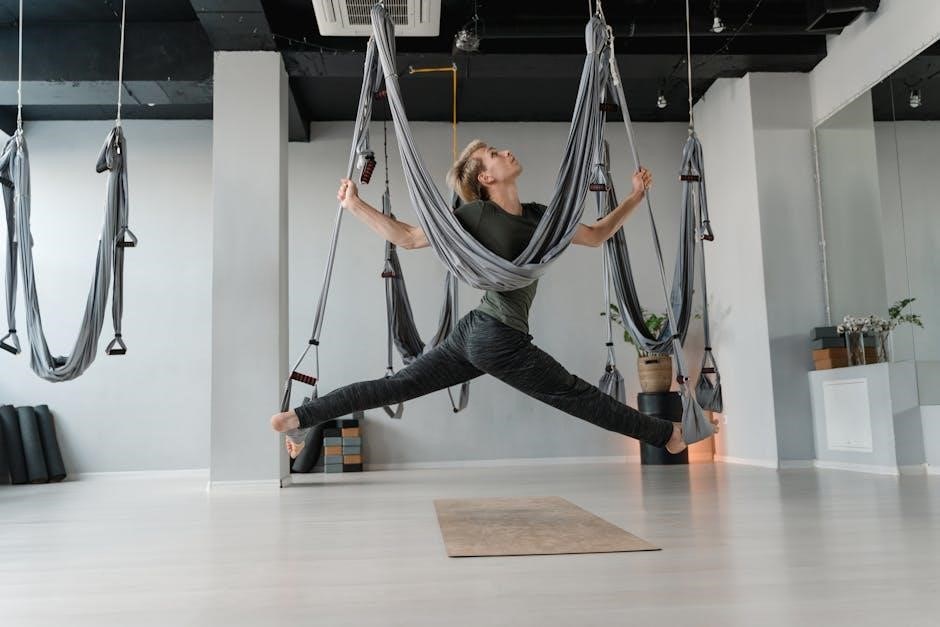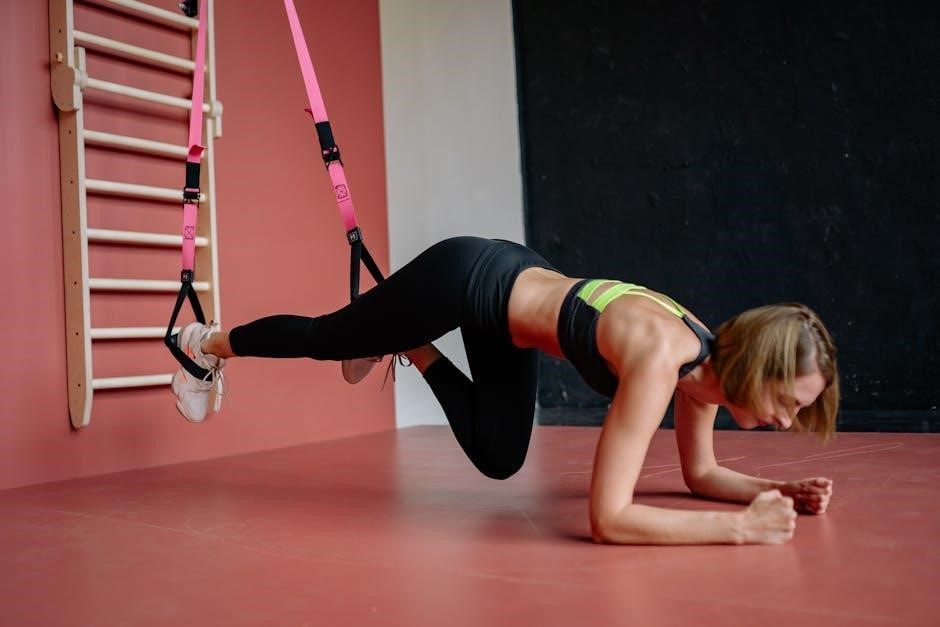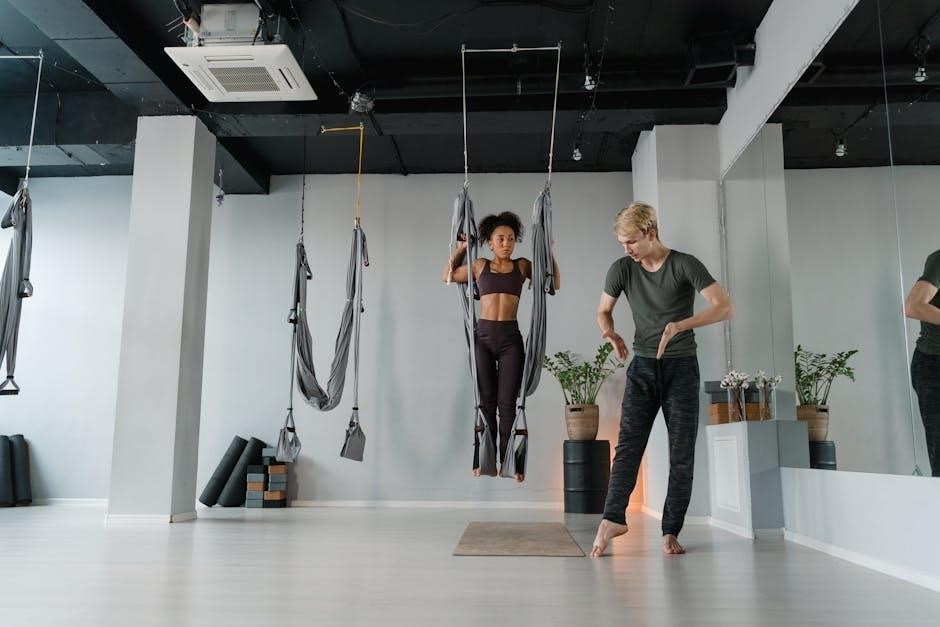
Suspension training is a versatile, bodyweight-based workout system offering full-body strength and cardiovascular benefits. Portable and space-efficient, it uses suspension straps to engage core and stabilizer muscles, with downloadable PDF guides providing structured routines for all fitness levels.
What is Suspension Training?
Suspension training is a bodyweight-based workout system using suspension straps anchored to a stable point. It engages multiple muscle groups simultaneously, improving strength, balance, and flexibility. The adjustable straps allow for varying resistance levels, making it suitable for all fitness levels. This versatile method enhances core stability and functional movement, offering a full-body workout. Suspension training is portable and space-efficient, ideal for home, gym, or outdoor use. With downloadable PDF guides available, users can access structured routines and progressions, ensuring a comprehensive and effective fitness experience. Its adaptability and efficiency make it a popular choice for achieving overall physical fitness.
History and Origins of Suspension Training
Suspension training originated from Navy SEAL Randy Hetrick’s innovative approach to fitness during deployments. In the late 1990s, Hetrick created the first prototype using a jiu-jitsu belt and rope, aiming to provide a portable workout solution; This concept evolved into the TRX (Total Body Resistance Exercise) system, which became widely recognized for its effectiveness. Over time, suspension training gained popularity worldwide as a versatile and efficient method for strength and conditioning. Its origins reflect the need for functional, space-efficient workouts, making it accessible to individuals at all fitness levels. Today, it remains a cornerstone of modern fitness training.
Key Principles of Suspension Training

Suspension training relies on bodyweight exercises performed with straps or ropes, leveraging gravity and instability to engage muscles. The system emphasizes functional movements that improve strength, balance, and mobility. A core principle is dynamic tension, where constant engagement of stabilizer muscles enhances overall stability. Adjusting the angle of the body relative to the anchor point modifies resistance, allowing customization for all fitness levels. Proper form and control are essential to maximize effectiveness and prevent injury; These principles, detailed in PDF guides, ensure a comprehensive and adaptable workout experience, making suspension training versatile for various goals and fitness levels. Regular practice enhances overall physical resilience and coordination.

Benefits of Suspension Training Workouts
Suspension training offers a full-body workout, improving strength, cardiovascular health, and flexibility. It enhances balance, core stability, and mobility while being efficient and scalable for all fitness levels.
Full-Body Strength and Cardiovascular Workout
Suspension training delivers a comprehensive workout that combines strength and cardiovascular benefits. By engaging multiple muscle groups simultaneously, it enhances overall fitness efficiently. The portable equipment allows for workouts anywhere, making it ideal for those seeking a space-saving routine. Suspension training not only builds lean muscle but also elevates heart rate, providing a cardio challenge. Proper form and dynamic warm-ups are essential for maximizing results and preventing injury. Whether you’re a beginner or advanced, suspension training offers scalable intensity, ensuring a full-body workout that strengthens and conditions the body while improving cardiovascular health. Downloadable PDF guides provide structured routines for all fitness levels.
Portability and Space Efficiency
Suspension training is renowned for its portability and space efficiency, making it a convenient option for any fitness routine. The lightweight equipment can easily fit into a shoebox, allowing users to train anywhere, whether at home, in the gym, or while traveling. Its compact design requires minimal space, making it ideal for small areas or outdoor setups. This portability ensures that you can access a full-body workout without being tied to a specific location. With downloadable PDF guides, you can carry your workout plans wherever you go, maintaining consistency and progression in your fitness journey.
Customizable Difficulty for All Fitness Levels
Suspension training offers unparalleled customization, catering to all fitness levels by adjusting body positioning and resistance. Beginners can start with modified exercises, while advanced users can increase difficulty by changing their stance or angle. This versatility ensures that workouts remain challenging yet achievable, promoting progressive overload for continuous improvement. With downloadable PDF plans, users can tailor routines to match their goals, whether focusing on strength, endurance, or mobility. This adaptability makes suspension training an inclusive and effective method for individuals at any stage of their fitness journey, ensuring everyone can benefit from its comprehensive approach to full-body conditioning.
Improved Balance and Core Stability
Suspension training is renowned for enhancing balance and core stability by engaging the body’s stabilizer muscles. The unstable nature of suspension straps requires constant engagement of the core, improving proprioception and overall stability. This makes it an excellent method for enhancing functional strength and reducing injury risk. Exercises like single-leg movements and suspended planks specifically target balance and core muscles. Downloadable PDF guides often include routines focused on these benefits, helping users progress from basic to advanced movements. By challenging the body to maintain control, suspension training builds a strong, stable foundation for everyday activities and athletic performance.

Equipment and Setup
Suspension training requires a durable trainer, secure anchor points, and proper strap adjustment. Ensure safe setup by following manufacturer guidelines, using sturdy anchors, and consulting downloadable PDF guides for optimal configuration.

Understanding the Suspension Trainer
The suspension trainer is a portable fitness tool consisting of adjustable straps with anchors and foot cradles. It leverages gravity and bodyweight to create resistance, enabling exercises that target strength, flexibility, and balance. The system allows for easy adjustment of resistance levels by changing body position relative to the anchor point. This versatility makes it suitable for both beginners and advanced users. Available PDF guides provide detailed setups and routines, ensuring safe and effective use. Proper configuration is essential for maximizing results and preventing injury, making it a reliable option for home or gym workouts.
How to Properly Configure the Suspension Trainer
Properly configuring the suspension trainer ensures safety and effectiveness. Begin by securing the anchor point at a stable height, typically chest level, and adjust the straps to equal length. Attach the foot cradles and test the system’s stability. Adjust the strap length by pulling the handles or foot loops to the desired resistance level. For most exercises, the straps should be fully extended but not over-tightened. PDF guides often include setup checklists to help users verify their configuration. Proper setup ensures even weight distribution and prevents equipment failure during workouts, making it crucial for achieving optimal results safely.
Essential Accessories for Suspension Training
Key accessories for suspension training include durable anchors, door brackets, and high-quality straps to ensure stability. Handles and foot cradles are essential for grip and comfort. Optional accessories like grip enhancers, such as gloves, can improve control during workouts. A heart rate monitor is useful for tracking intensity. Anchors and brackets must be sturdy to support body weight safely. PDF guides often recommend these accessories to maximize the effectiveness and safety of suspension workouts. Investing in proper equipment ensures a smooth and injury-free training experience, allowing users to focus on achieving their fitness goals.
Suspension Training Workout Plans
Suspension training offers structured workout plans in PDF format, providing customizable routines for all fitness levels. These plans ensure full-body engagement and effective progression, maximizing workout results.
Beginner-Friendly Suspension Training Routines
Beginner-friendly suspension training routines focus on simplicity and gradual progression. Start with basic movements like chest presses, rows, and squats, using the suspension straps to support proper form. These exercises build foundational strength and stability while engaging the core. Many PDF guides offer step-by-step instructions, making it easy to follow structured workouts. Begin with shorter sessions, ensuring proper form and technique. As confidence grows, gradually increase intensity by adjusting body positioning or adding repetitions. These routines are perfect for newcomers, providing a safe and effective introduction to suspension training while promoting overall fitness and mobility.
Intermediate and Advanced Workout Options
Intermediate and advanced suspension training options challenge users with dynamic movements and increased intensity. Incorporate exercises like single-arm chest presses, plyometric rows, and balance-intensive lunges. These routines target specific muscle groups while enhancing coordination and endurance. PDF guides offer detailed workout plans, including time-efficient circuits and high-intensity interval training (HIIT). Advanced users can modify exercises by adjusting strap length or incorporating instability. These workouts push limits, improving strength, flexibility, and cardiovascular fitness. They are ideal for those seeking progression beyond basic routines, ensuring continuous growth and engagement in their suspension training journey.

Full-Body Suspension Training Workout Plan
A full-body suspension training workout plan integrates exercises targeting all major muscle groups, enhancing strength, flexibility, and cardiovascular health. It typically includes circuits like chest presses, rows, squats, and planks, ensuring comprehensive engagement. The plan can be customized to fit individual goals, with options to increase intensity or focus on specific areas. Many PDF guides offer structured routines, detailing sets, reps, and rest periods. This approach promotes balanced development and maximizes efficiency, making it ideal for those seeking a holistic fitness regimen. Regular progression tracking helps users stay motivated and achieve long-term results.
Daily TRX Workout Plan PDF Download Options
Daily TRX workout plans in PDF format offer structured routines for consistent progress. These guides provide detailed exercises, sets, and reps, catering to all fitness levels. Many PDFs include variations for specialization, such as strength or cardio-focused workouts. Users can download plans tailored to specific goals, ensuring variety and engagement. Promo codes like TRX15LUKAS often apply to PDF purchases, offering discounts on comprehensive training tools. These resources are perfect for those seeking organized, efficient workouts from home or on the go, with options to track progress and stay motivated throughout their fitness journey.

Key Suspension Training Exercises
Suspension training exercises engage multiple muscle groups, promoting full-body strength and mobility. They include functional movements like chest presses, rows, and squats, optimizing core stability and balance.
Basic Suspension Training Movements
Basic suspension training movements include push, pull, and squat exercises that engage the core and improve balance; These foundational moves, like chest presses and rows, use bodyweight resistance. By adjusting strap length and body angles, users can modify difficulty. Proper form is crucial to avoid injury and maximize results. Dynamic warm-ups and progressions are often included in workout plans to ensure safety and effectiveness. These exercises are versatile and can be adapted to suit different fitness levels, making them accessible for beginners and challenging for advanced trainees. They form the building blocks of a full-body workout that enhances strength and mobility efficiently.
Functional Exercises for Strength and Mobility
Functional exercises in suspension training focus on improving strength and mobility through dynamic movements. These exercises mimic real-life actions, enhancing coordination and balance. Moves like single-leg squats and rotational presses target multiple muscle groups, boosting functional fitness. They also promote injury rehabilitation by strengthening stabilizer muscles. With adaptable resistance levels, these exercises cater to diverse fitness goals. Incorporating functional exercises into a workout plan ensures comprehensive physical development, making daily activities easier and improving overall athleticism. They are a cornerstone of suspension training, offering a practical approach to building strength and mobility efficiently and effectively for all fitness levels.

Progressions and Regressions for Each Exercise
Suspension training exercises can be modified to suit different fitness levels by adjusting angles, distance from the anchor point, or adding tempo. Progressing an exercise might involve increasing the angle of your body or moving further from the anchor, which escalates resistance. Regressing involves decreasing the angle or moving closer to reduce intensity. Additionally, pauses or controlled movements can enhance challenge. These adjustments ensure workouts remain effective as fitness improves. Properly scaling exercises allows individuals to gradually build strength and mobility without risking injury, making suspension training accessible and adaptable for all participants. This versatility is a key advantage of the system.
Safety and Form
Proper form and dynamic warm-ups are essential for injury prevention in suspension training. Focus on controlled movements and body alignment to ensure safe and effective workouts.
Importance of Proper Form in Suspension Training
Maintaining proper form is crucial in suspension training to prevent injuries and maximize results. Incorrect posture can lead to muscle imbalances or strains. Focus on engaging core muscles, maintaining balance, and controlling movements. Proper form ensures that exercises target the intended muscle groups effectively. Dynamic warm-ups prepare the body for strain, while avoiding common mistakes like overreaching or losing tension ensures safety. Downloadable PDF guides often include tips to perfect form, helping users achieve a safe and effective workout. Prioritizing form enhances strength, stability, and overall fitness outcomes in suspension training routines.
Dynamic Warm-Up Exercises for Suspension Training
A dynamic warm-up is essential before suspension training to prepare muscles and prevent injuries. Incorporate movements like arm circles, leg swings, and torso twists to increase blood flow. Suspension trainers can be used for dynamic stretches, such as chest opens or side bends. These exercises improve flexibility and activate core muscles. A proper warm-up also enhances coordination and balance. Aim for 5-10 minutes of dynamic movements to ensure your body is ready for the workout. Many suspension training PDF guides include specific warm-up routines to follow for optimal preparation and safety. Consistency in warming up improves overall training efficiency and reduces injury risk.
Common Mistakes to Avoid During Workouts
When performing suspension training, it’s crucial to avoid common mistakes to ensure safety and effectiveness. Neglecting proper form is a frequent error, which can lead to injury or reduced results. Overreaching or using excessive range of motion can strain joints. Another mistake is failing to adjust the strap length correctly, leading to improper alignment. Ignoring a dynamic warm-up can increase injury risk. Additionally, rushing through exercises or using momentum instead of controlled movements can compromise the workout. Many suspension training PDF guides highlight these pitfalls, emphasizing the importance of focus and technique to maximize benefits and prevent harm. Awareness is key to a safe and successful session.

Nutrition and Recovery
Proper nutrition and recovery are vital for optimizing suspension training results. Balanced meals, hydration, and post-workout strategies support muscle repair and energy replenishment, enhancing overall performance and health.
Nutritional Tips for Maximizing Workout Results
To optimize your suspension training workouts, focus on a balanced diet rich in lean proteins, complex carbohydrates, and healthy fats. Prioritize post-workout protein intake to aid muscle recovery and growth. Hydrate adequately before, during, and after sessions to maintain performance and prevent fatigue. Incorporate nutrient-dense foods like fruits, vegetables, and whole grains to fuel your body. Avoid excessive sugar and processed foods, which can hinder progress. Timing your meals around workouts, such as a light snack 1-2 hours before training, can enhance energy levels and endurance. A well-planned diet supports your suspension training goals and overall fitness journey.
Post-Workout Recovery Strategies
Effective recovery after suspension training is crucial for muscle repair and performance improvement. Incorporate stretching and foam rolling to relieve tension and improve flexibility. Prioritize sleep, aiming for 7-9 hours nightly, to support muscle regeneration. Use techniques like contrast showers or ice baths to reduce inflammation. Supplements such as protein shakes or recovery powders can aid in muscle replenishment. Active recovery, like light walks or yoga, promotes blood flow without overexertion. Additionally, consider massage therapy to target tight muscles. A structured recovery routine enhances overall fitness and prepares your body for future workouts, ensuring sustained progress in your suspension training journey.
Hydration and Its Role in Suspension Training
Hydration is essential for optimal performance in suspension training, as it supports physical stamina and prevents dehydration. Water composes 83% of blood and 80% of sweat, making it vital for regulating body temperature and maintaining energy levels. Even mild dehydration can lead to fatigue, dizziness, and decreased focus, hindering workout effectiveness. Staying hydrated helps lubricate joints and transport nutrients to muscles, enhancing recovery. Aim to drink 17-20 ounces of water 2-3 hours before training, 8-10 ounces every 10-15 minutes during exercise, and replenish lost fluids post-workout. Proper hydration ensures safety and maximizes the benefits of suspension training workouts.
Progress Tracking and Variations
Track progress by increasing resistance, reps, or intensity. Explore variations like combining suspension training with cardio or yoga for a diverse workout. Use PDF guides for structured plans.
How to Track Progress in Suspension Training
Tracking progress in suspension training involves monitoring strength gains, endurance, and form improvements. Start by assessing your ability to perform exercises with proper form and control. Over time, increase the difficulty by adjusting your body position or adding more repetitions. Use a workout log to record the number of reps, sets, and time under tension. Improvements in balance and core stability can also indicate progress. Incorporate TRX PDF guides to follow structured routines and track advancements. Regularly test your max reps or time for specific exercises to measure growth. Celebrate small victories to stay motivated and committed to your fitness journey.
Incorporating Suspension Training into Your Fitness Routine
Suspension training seamlessly integrates into any fitness routine, offering a versatile and efficient way to build strength and endurance. Start by incorporating 2-3 TRX sessions per week, focusing on full-body workouts. Use downloadable PDF guides to structure your routines and progressively increase intensity. Combine suspension exercises with cardio or yoga for a well-rounded regimen. The portability of suspension straps makes it ideal for home, gym, or outdoor use. Mix TRX workouts with weightlifting or functional training to enhance overall fitness. This holistic approach ensures balanced development and keeps your workouts engaging and challenging over time.

Combining Suspension Training with Other Workouts
Suspension training enhances traditional workouts by adding functional strength and mobility. Combine TRX exercises with cardio routines for improved endurance or incorporate them into yoga for better alignment and support. Mix suspension movements with weightlifting to target stabilizer muscles, boosting overall strength. For a holistic approach, blend TRX workouts with Pilates or functional training to enhance core stability and flexibility. Downloadable PDF guides provide structured plans to integrate suspension training into diverse fitness regimens, ensuring a well-rounded and engaging workout experience. This versatility makes suspension training an ideal addition to any fitness program, helping to achieve balanced physical development.
Suspension training offers a versatile, portable, and customizable workout solution, ideal for full-body strength and cardiovascular fitness. With downloadable PDF guides, it’s accessible for all fitness levels, anytime, anywhere.
Final Thoughts on Suspension Training Workouts
Suspension training workouts are a highly effective and versatile method for improving strength, cardiovascular health, and flexibility. With its portable design and customizable difficulty, it suits all fitness levels. The availability of downloadable PDF guides ensures structured routines and progression tracking. suspension training engages core muscles and enhances balance, making it ideal for functional fitness. Whether at home or in a gym, suspension training offers a comprehensive workout. Embrace this dynamic system to achieve your fitness goals and transform your body with consistent practice and dedication.
Encouragement to Start Your Suspension Training Journey
Embrace the transformative power of suspension training and take the first step toward a stronger, leaner, and more balanced you. With its portability and versatility, suspension training offers a full-body workout that fits into any lifestyle. Whether you’re a beginner or an advanced athlete, downloadable PDF guides provide structured routines to keep you motivated and progressing; Don’t wait—start your journey today and experience the empowering benefits of suspension training. Transform your fitness journey with this dynamic and effective system that delivers results and keeps you engaged every step of the way.





